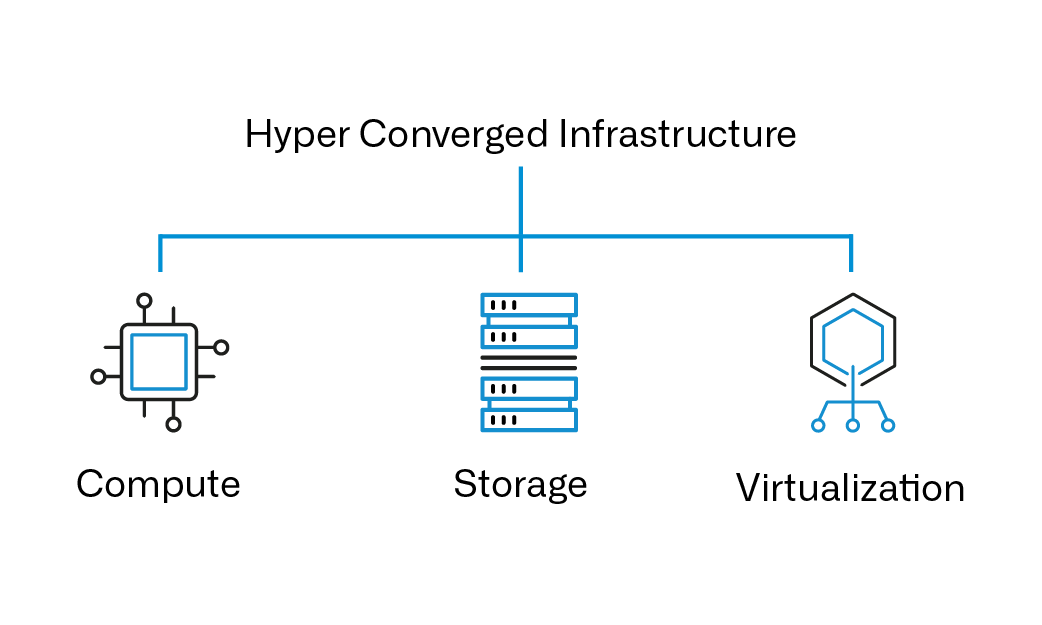Hyper Converged Infrastructure (HCI) is playing an increasingly important role in the data centre. HCI solutions offer integrated server, storage and network components as well as virtualisation and management software in a single system. They are flexibly scalable, reduce costs and simplify management.
The benefits of hyper-converged solutions are clear when you look at the current situation in many medium-sized enterprises. In their data centres there are often servers, storage systems and networks from different manufacturers running in parallel to each other, with different operating systems, management software and network protocols. It is a lot of work for the IT department to keep this heterogeneous system landscape running. Over time, integrating the solutions becomes increasingly difficult due to incompatibilities resulting from all the updates and patches.
This non-uniform infrastructure not only leads to higher costs and a lack of flexibility, but also takes up resources which are then lacking for pioneering digital projects. One remedy is Hyper Converged Infrastructure (HCI). The market figures underline its relevance. Sales of these kinds of solutions have increased dramatically in recent years. An example: According to market researchers from IDC, HCI systems with a value of more than 1.8 billion US dollars were sold worldwide in the second quarter of 2019. This is a growth of around 24 per cent compared to the previous year.
What is HCI?
Converged becomes hyper-converged
A step towards HCI and simpler IT administration is/was initially the concept of converged infrastructure. These solutions unite computers, servers, storage and networks in a single box, which can be managed centrally. The products’ hardware and software are preconfigured and come from a single provider. These can be used to run VDIs with virtual desktops, a database or a specific application. A convergent infrastructure can be partially virtualised, but it doesn’t have to be. The problem: when using converged infrastructure, being tied to a single manufacturer makes integration of the existing infrastructure almost impossible.

HCI or hyper-convergent infrastructures take things a step further, by relying consistently on virtualisation of the servers, storage and the network, as well as having a software-focused architecture. They also exist as a single appliance, combining all the necessary IT resources into a single unit. As HCI is focused on virtual machines and applications, companies can decouple their workloads from the physical infrastructure. The virtualisation software abstracts the underlying resources, pools them together and then assigns them to dynamically-executed applications in virtual machines or containers.
Furthermore, HCI offers additional functions such as deduplication, data compression for transport via the network, backup and recovery, and WAN optimisation. The solutions also include gateways to the cloud connection, or can be embedded in a disaster recovery concept which is spread over multiple data centres. With HCI, all the IT is administrated and controlled via a central software platform, usually in the form of a web front-end.
The advantages of HCI
Hyper-convergent systems create a consolidated, centrally-administrated environment and offer multiple advantages:
Flexible and scalable: Since resources (servers, storage, networks) are easy to add as needed, companies can react to new business demands with flexibility and agility.
Highly available: A hyper-converged infrastructure generally consists of a cluster with at least two systems. If one server fails, the second takes over. Availability is increased further thanks to the concentration on virtual machines.
Easier to manage: As HCI consolidates all the required IT resources, conventional IT silos are consigned to history. Administrators can view all the resources and associated hardware in the administration console at a glance. IT teams no longer require specialists for the individual data centre features (servers, storage, networks). Instead, it is easy for one employee to control the HCI environment and provision all the resources. Thanks to automation, many tasks can be performed rapidly and based on existing guidelines.
Safeguarding data: Backup, restore and disaster recovery are fixed components of HCI. This ensures the necessary safeguarding of data in your everyday business: additional investment for appropriate systems is not required.
Reduced costs: HCI reduces investment cost, because companies no longer need additional components such as storage systems or SAN switches. In addition, the costs for administration, operation and licenses are also lower. Expensive specialised hardware is not required, because existing software and x86 servers can be used as a basis. This makes a wider range of hardware available, and companies become more independent from individual hardware providers.
Efficient: Thanks to deduplication and data compression, HCI reduces the demands on storage, bandwidth and IOPS.
Powerful: As the IT resources of an HCI can be pooled, they provide guaranteed performance for many applications. In addition, thanks to virtualisation, it is possible to assign resources to individual workloads in a focused way, as they are needed.
It depends on the requirements
The choice of HCI solution depends upon the requirements and application in the company concerned. Does the complete package serve as a basis for specific scenarios, such as server virtualisation, VDI, big data analytics or application development? Does the HCI system simplify IT infrastructure management for small and medium-sized companies which do not have much IT manpower or many branch offices? Or are large companies using it to transform their data centre environment?
HCI is fundamentally suited to a wide range of applications, from business-critical applications and virtual desktop infrastructure (VDI), through to disaster recovery, internal and external cloud scenarios, DevOps and containerised applications. Exciting times.
Lenovo ThinkAgile HX Series with Nutanix
One example of an HCI solution is the ThinkAgile HX Series from Lenovo. It combines reliable and scalable Lenovo servers with software from Nutanix, the HCI pioneer, and was developed for simple operation in scale-out clusters. The Lenovo ThinkAgile HX Series removes IT silos, reducing complexity for servers, storage and virtualisation in data centres of all sizes.
Find out more here.
Questions?
Just ask!
I am Sebastian Wiedemann from the HCD sales team. I will be happy to advise you or assist you with any questions. You can phone me on +49 89 215 36 92-0 or reach me using our contact form.
Contact us
 Deutsch
Deutsch